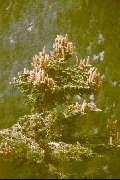
For this and other photos, including 8 landscape shots of this species in habitat, see "Foreste & Dintorni" by Enrico Rovelli.
Trees in the mountains of Valtos, central Greece [Daniel Adam, 2020.10.05, Facebook post].

For this and other photos, including 8 landscape shots of this species in habitat, see "Foreste & Dintorni" by Enrico Rovelli.
Trees in the mountains of Valtos, central Greece [Daniel Adam, 2020.10.05, Facebook post].
Abies cephalonica
Κεφαλληνιακή ελάτη [Greek]; Grecian fir [English].
Synonyms for the type (Farjon 1998):
The natural hybrid of this species with A. alba is A. borisii-regis. You may see a reference to Abies cephalonica var. graeca (Frans) Liu 1971. This taxon is now generally called Abies nordmanniana subsp. equi-trojani.
A broadly pyramidal tree to 30 m tall, 2.7-4.5 m girth, with long horizontal branches. Bark grey-brown, smooth, becoming fissured into oblong plates. Branchlets smooth, bright brown or reddish-brown. Buds conical or ovoid, resinous, scales visible at the apex, surrounded by the leaves, violet to reddish, somewhat pubescent, 1.2-1.6 mm diameter. Needles spirally arranged, not or rarely grooved above, keeled below, dark shiny green above, greenish-white below; with 2-3 short stomatal lines above and 6-7 lines below; 15-35 mm long by 2-3 mm wide, flattened in cross-section, apex sharp-pointed. Male cones ovoid, 14 mm long by 4 mm wide. Female cones narrowly cylindrical, brownish-red to violet, apex obtuse or with a nipple, somewhat resinous, 12-16 cm long by 3.8 cm wide; scales cuneiform, somewhat triangular; bracts short, erect, slightly protruding, golden-brown, triangularly pointed, about 2/3 the height of the scale. Seeds angular, reddish, winged, 12-19 mm long (Silba 1986). See García Esteban et al. (2004) for a detailed characterization of the wood anatomy.
Greece: Cephalonia, Euboea, Sterea Hellas and Peloponnesos, at 600-2100 m elevation, primarily on calcareous soils; climate Mediterraenean, with 750-1500 mm annual precipitation. Mostly forms pure stands; at lower elevations, occurs with Fagus orientalis, Quercus spp., Castanea sativa, Pinus nigra. Northern portions of its range show evidence of past and perhaps ongoing hybridization with Abies alba (cf. A. borisii-regis), which complicates the conservation of this species (Farjon 2010). Hardy to Zone 5 (cold hardiness limit between -28.8°C and -23.3°C) (Bannister and Neuner 2001).
Distribution of Abies in the Mediterranean region. Data from Conifers of the World BRAHMS database, downloaded 2017.11.05. Taxa are color coded; see pull-out menu at left of map for details. Click on each occurrence for further information.
I have no data on trees in their native range. Great Britain has a tree 116 cm dbh and 38 m tall at Bodnant, Gwynedd. One at Woodstock, Co. Kilkenny, Ireland has a dbh of 177 cm and is 36 m tall (Mitchell et al. 1990).
A tree-ring chronology covering the period 1676-1978 (303 years; crossdated after 1837) was collected in 1978 at Scotida Forest, Kastoria, Greece by Peter Kuniholm (doi.org/10.25921/mdh4-e656). Very few collections of this species are recorded and substantially older trees may occur.
No data as of 2023.02.22.
No data as of 2023.02.22.
The epithet refers to the Greek island of Cephalonia (Κεφαλονιά), and this fir still dominates the flora of Ainos National Park there.
Elwes and Henry 1906-1913 at the Biodiversity Heritage Library (Photos). This series of volumes, privately printed, provides some of the most engaging descriptions of conifers ever published. Although they only treat species cultivated in the U.K. and Ireland, and the taxonomy is a bit dated, still these accounts are thorough, treating such topics as species description, range, varieties, exceptionally old or tall specimens, remarkable trees, and cultivation. Despite being over a century old, they are generally accurate, and are illustrated with some remarkable photographs and lithographs.
Farjon, Aljos. 1990. Pinaceae: drawings and descriptions of the genera Abies, Cedrus, Pseudolarix, Keteleeria, Nothotsuga, Tsuga, Cathaya, Pseudotsuga, Larix and Picea. Königstein: Koeltz Scientific Books.
- Provides a detailed account, with illustrations.
Last Modified 2025-03-01